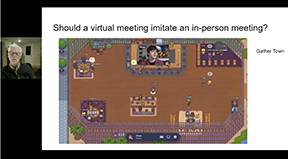
There are many differences between making a virtual event and a physical event accessible. While you may not have to consider the actual ease of getting around in a space, or whether everyone can access the stage to present, you may need to consider whether the technology is set up for everyone to be successful to participate. While you may not have to worry about a tactile map or physical guide for participants who are blind, you may want to set up precedence for people to describe themselves before they present. Issues with individual reactions to certain foods and flash photography may go away but new issues arise that prevent or inhibit participation. Some accommodations will stay the same but may look different in how they are implemented, like captions or a sign language interpreter for deaf participants.
In a presentation given in March for the Social Presence in Virtual Event Spaces series, AccessComputing PI Richard Ladner reviewed some of the accessibility issues that arise that may prevent or inhibit participation by event attendees with disabilities and suggests some solutions to these issues. Some of the solutions can be solved with technology, but others may need behavioral changes by participants and presenters. In terms of enhancing social presence, Richard also discusses some approaches that may work with diverse participants including those with disabilities.
Watch the presentation on YouTube.